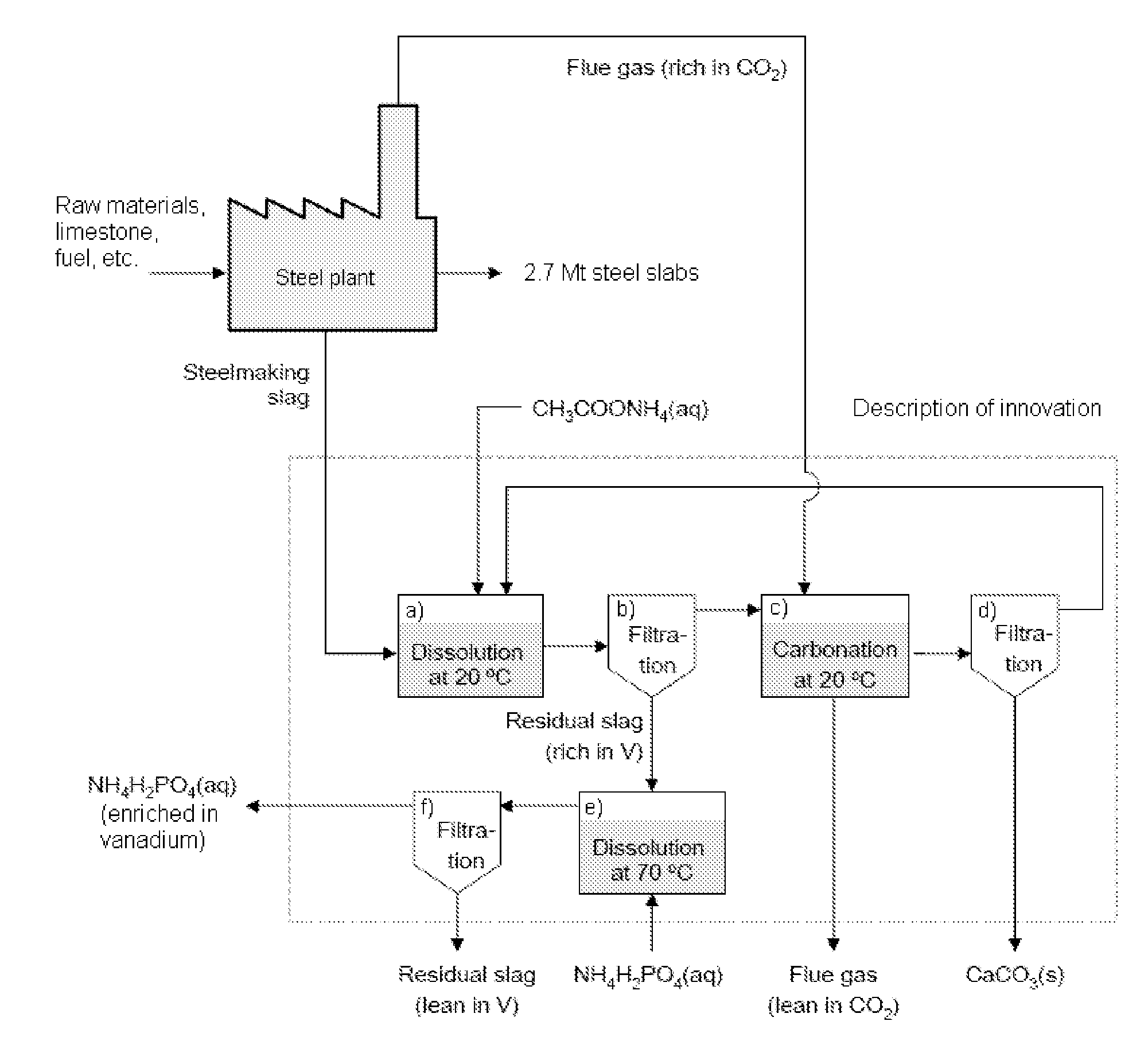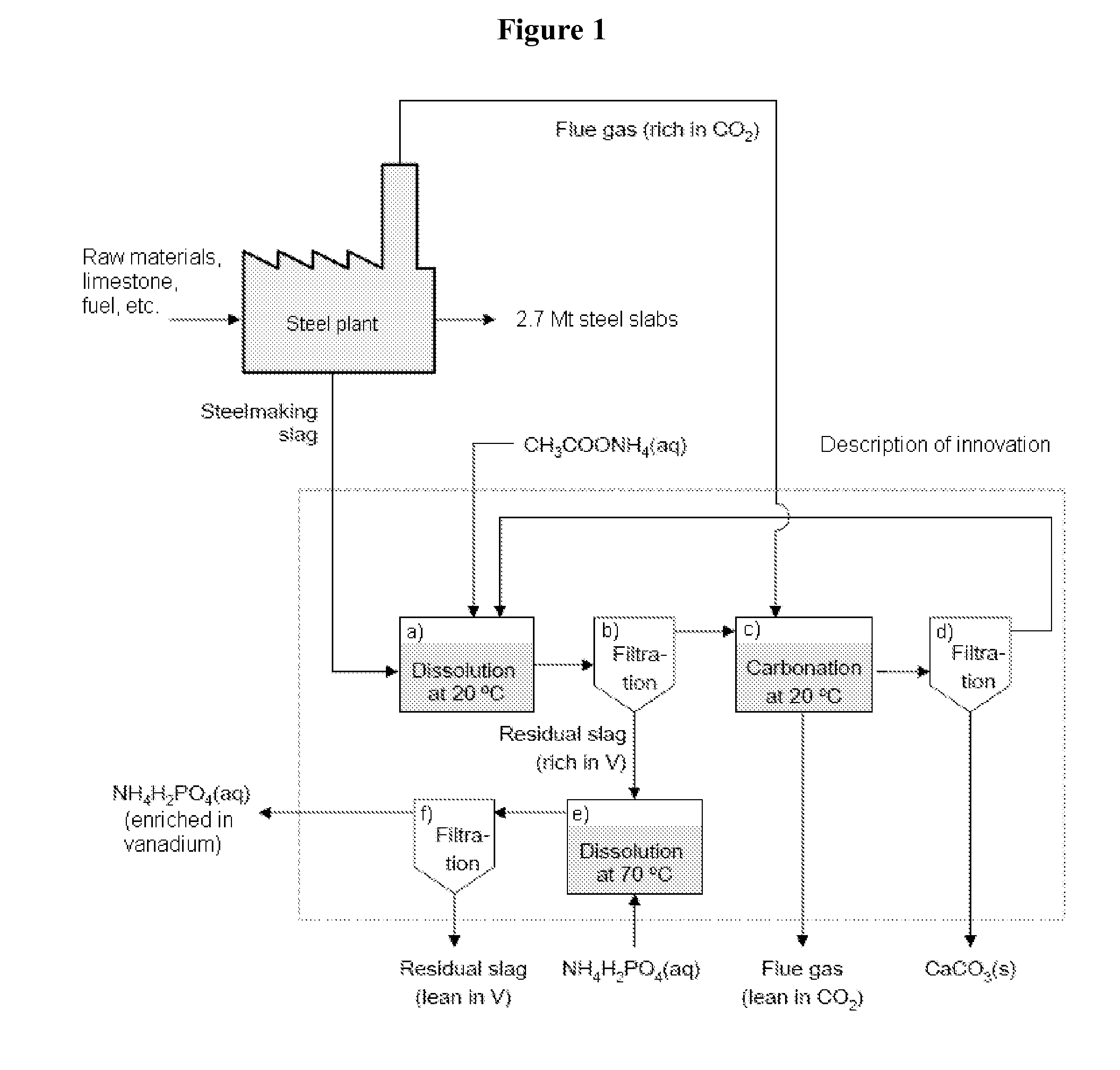Method of producing calcium carbonate from waste and byproducts
- Summary
- Abstract
- Description
- Claims
- Application Information
AI Technical Summary
Benefits of technology
Problems solved by technology
Method used
Image
Examples
example 1
Extraction of Calcium from Steel Converter Slag
[0060]Experiments were performed to test the extraction of calcium from steel converter slag. Batches of 1 g of the steel converter slag (74-125 μm) were dissolved in separate 50 ml aqueous solutions of respective ammonium salt solvent (acetate, nitrate and chloride) in concentrations of 0.5 M, 1 M and 2 M in sealed Erlenmeyer flasks. Each experiment was performed three times to increase the reliability and repeatability of the results. The solutions were stirred at 100 rpm at room temperature (20° C.), and 1 h after the addition of the slag filtered using 0.45 μm filters. The concentrations of Ca, Si, Fe, Mg, Al, Mn, V, and Cr (the main elements in steel converter slag) were measured in the filtered solutions with Inductively Coupled Plasma-Atomic Emission Spectrometry (ICP-AES). The steel converter slag fraction used was also analyzed using total digestion and ICP-AES, and a sample of the batch was sent for X-Ray Fluorescence (XRF) an...
example 2
Extraction of Vanadium from Steel Converter Slag
[0062]Using a 1 M aqueous solution of ammonium dihydrogen phosphate and maintaining the temperature at room temperature (20° C.), 25% of the vanadium in the steelmaking slag was extracted (FIG. 5), leaving, however, most of the undissolved calcium. Further, 36% of the silicon dissolved into the solution, which means that the extraction of vanadium could be performed at elevated temperatures, such as temperatures of 60-80° C., where dissolved silicon precipitates as silica gels, leaving a large concentration of vanadium in the solution. Therefore, using ammonium dihydrogen phosphate, selective extraction of vanadium is possible.
example 3
[0063]Carbonation of aqueous solutions containing ammonium salts and calcium dissolved from steel converter slag was tested at 30° C. and 70° C. The experiments were performed in a glass reactor (1000 ml), which was heated by a temperature-controlled water bath. The reactor was connected to a tap-water condenser to prevent losses due to evaporation of solvent from the solution. The solution temperature and the pH were continuously monitored. The solution was stirred at 600-700 rpm using a magnetic stirrer. After heat-up to the desired temperature under nitrogen flow (bubbled through the solution at 1 l / min), the nitrogen flow was replaced with a carbon dioxide gas flow (1 l / min). After 70 minutes of continuous exposure to the carbon dioxide flow, the reactor was removed from the bath and the solution was filtered using 0.45 μm membranes. The precipitate was washed and dried at 115-120° C. overnight. The precipitates were analyzed using XRD, XRF, Total Carbon (TC) and Scan...
PUM
| Property | Measurement | Unit |
|---|---|---|
| Temperature | aaaaa | aaaaa |
| Temperature | aaaaa | aaaaa |
| Temperature | aaaaa | aaaaa |
Abstract
Description
Claims
Application Information
 Login to View More
Login to View More - R&D
- Intellectual Property
- Life Sciences
- Materials
- Tech Scout
- Unparalleled Data Quality
- Higher Quality Content
- 60% Fewer Hallucinations
Browse by: Latest US Patents, China's latest patents, Technical Efficacy Thesaurus, Application Domain, Technology Topic, Popular Technical Reports.
© 2025 PatSnap. All rights reserved.Legal|Privacy policy|Modern Slavery Act Transparency Statement|Sitemap|About US| Contact US: help@patsnap.com



